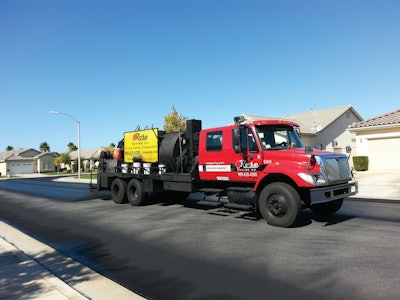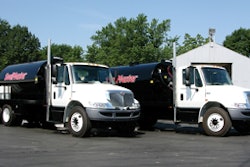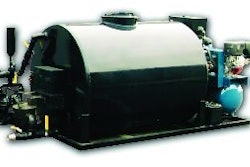
Not all contractors are equipped to tackle a 2 million-sq.-ft. sealcoating job, especially one that lacks a scope of work and where any proposal must negotiate its way among 10 board members and 1,200 homeowners, all of whom feel they have a vested interest in the work.
But that’s the challenge Rose Paving’s Pacific Division faced last year when Account Executive Sean Hansen learned while visiting his grandmother that The Oasis, a gated over-55 homeowners association (HOA) community, was looking to get some work done on its roads. Hansen walked the pavement, met the property manager, asked some questions and eventually Rose Paving was one of three contractors asked to put together a proposal and estimate.
“It was early in the project so there was no scope or direction,” says David Cohen, general manager. “They said ‘do what you would do to our pavements.’ They were clearly looking for someone to come in and tell them what they needed and create a budget for them.”
After some discussion with Oasis representatives Hansen devised a scope and presented it to the board. “When we were done they said ‘that makes complete sense’,” Cohen says. A second meeting involving Bill Keller, director of operations, and Rose Paving’s SealMaster rep (who provided lunch) followed where they discussed materials and application methods.
“That meeting went extremely well,” Cohen says. “It showed support from our manufacturer and that we are not just mavericks trying to get this done but a cohesive unit…one team.”
Additional meetings followed where Rose also brought in Eddie Garcia, superintendent, and Danny Espinoza, project coordinator, who would be on the jobsite. It was during one of the later meetings that the Oasis board of directors had Cohen review everything discussed in previous meetings and talk about “Why Rose Paving”?
“At this point there were three of us competing and we figured we were the highest. We knew our competition well and where their weak spots were and where we could address what we do well,” Cohen says. “So we just had to explain ‘why Rose Paving’ and how we justified the additional cost.”
The Oasis Job
Cohen says that while the Rose Pacific Division regularly handles jobs as large as 1 million sq. ft., this job was on the larger side of the company’s business. “But it was right up our alley. If you had to design a job right in our wheelhouse, this was it,” Cohen says.
Ultimately the Oasis job was divided into two parts. The first part was completed in 2013; the second will be completed this spring. In 2013 Rose Paving cracksealed 24,000 linear feet of cracks, applied two coats of sealer to 1.2 million sq. ft. of roads, provided pavement marking including 24 STOP bars, removed and replaced 1,500 sq. ft. of patching, and placed a Type II slurry seal on almost 400,000 sq. ft. (the Type II slurry is going this spring as well) of pavement. This spring Rose will sealcoat more than 460,000 sq. ft., replace all pavement marking and remove and replace any remaining blue reflectors.
Located in Pomona, CA, the Rose Paving Pacific Division employs 18 people and runs three sealcoating crews, two cracksealing crews, two pavement marking crews and one paving and patching crew. Crews are made up of between 3 and 12 people depending on the job. “Normally when we estimate and phase a job we figure we can sealcoat an average of 200,000 sq. ft. a day (with two coats),” Keller says. “But we like to front-load the project so that if there are any problems -- a breakdown or weather issues or something – we have time to catch up and still hit our deadlines.
“So on Day One we might push to do 225,000 sq. ft. and by the end of the job on the last day we might be left with only 180,000 sq. ft. to do. So as the project size changes our crew size can change too. We might use 12 on the first day but by that last day only nine.” The 12 man crew includes crack seal and lot marking crew. For seal coat, the crew will range from 4 to 8 depending on size and scope.
Phasing for Efficiency
Rose had to be off the property by 5:00 p.m. each day, so phasing the job was important for both profitability and resident comfort. Rose bid the job to take eight days but once they were awarded the contract they decided they could complete the job in six. “That helped us out and it was easier on residents to have us out of there sooner,” Keller says.
Knowing its crews can spray apply two coats of sealer over 200,000 sq. ft. in a day, Rose planned the job assuming they could produce at a rate of 400,000 sq. ft. per day.
“When planning we estimate what our maximum efficiency is, what is the most we can do in a day and that was our starting point,” Keller says. “So based on that rate we try to determine how many days we need to get it done and keep our efficiency high while minimizing their disruption.”
Keller says that to reach that 200,000 sq. ft. rate “we pushed a little bit. We had a 2,000-gal. sealcoating truck, a 750-gal. truck, and a 300-gal. buggy out there every day. We usually don’t have all three on one job but it was all hands on deck to get it done.”
Using a Drop Tank
Keller says that to meet its deadline Rose Paving was going to work through a lot of sealer quickly, so making sure crews had enough material was a key concern. “To give us a head start we filled up each piece in the yard before leaving in the morning and then had a 6,000-gal. tanker delivered to the site,” he says.
He says Rose Paving Pacific uses tankers on many jobs, even jobs as small as 300,000 sq. ft. “We use them if there’s a reason to get in and out quickly and we use tankers on jobs that will take multiple days where it’s more efficient and cost-effective to not leave the site to fill up the equipment,” Keller says.
On the Oasis job Rose Paving used SealMaster MTR, which the contractor bought ready to use. “We prefer to buy the sealer pre-mixed because it’s exact and we know we’re meeting the manufacturer’s specs because we use what they deliver to us. That way we don’t have to worry about the integrity of the product,” Keller says.
SealMaster dropped a tank and then sent a tanker truck out to top off the tank at the end of each day. Keller says the tanker location is important and Rose had SealMaster drop it on the main roadway for easy access for delivery, easy crew access and an easy location fill the equipment – plus Keller says it was a safe location for the crew and it didn’t disrupt traffic. “We also wanted to make sure we didn’t have to move it every day,” he says.
Keller says that with the company located in Pomona crews are regularly sent to work as far as two hours away from the yard, so especially on larger jobs it makes sense to drop a tanker at the site. He says that when deciding whether a tanker is worthwhile Rose considers both the size of the project and the number of days it will take to complete.
“Even if it’s a one-day job, if we’re bringing out just our sealcoating truck it can do 90,000 sq. ft. a day and if a job is 150,000 sq. ft. or so we’ll get a tanker and just fill from the tanker. We also don’t want to be short of material and having a tanker onsite eliminates that problem.
“We’ll drop a 6,000-gal. tank even if we’re only putting down 2,000 or 3,000 gals. on a job,” Keller says. “It’s still beneficial from a material quality standpoint and from an efficiency standpoint because we don’t have to drive back and forth to fill equipment. One job was 900,000 sq. ft. over four days and it made sense to drop a tanker there rather than drive back to the yard to fill the equipment. We want to stay on the site and finish the job as quickly as we can.”
Keller says that there is a delivery charge when using a drop tank but says that there’s a delivery charge whether the material is delivered to their yard or to a jobsite.
He says some contractors are concerned about finishing a job and having material left over in the drop tank. “But on a recent job we had about 1500 gals. left over and we just filled all our equipment at the jobsite once we were done with the job, then drove them back to the yard so the equipment was filled and ready to go the next morning,” Keller says. “If we can’t do that for some reason SealMaster credits us for what’s left.
“We do just about anything we can to keep us from putting more miles and fuel costs on our equipment,” Keller says. “Plus using a drop tank is just more efficient.”
Executing the job
Keller says the Oasis job followed a typical approach Rose Paving uses on similar types of jobs. On the first day Rose Paving crews helped get homeowners out of the area by 7:00 a.m., then put up signs and blocked the appropriate streets. Cracksealing crews hit the road first, followed by pavement cleaning crews and then the sealcoating crew. A second coat of sealer was applied later the same day, so that was the only day that area was shut down. Rose crews shut down each area at 7:00 in the morning and opened the area at 7:00 a.m. the next day.
“We also took the board president out there in the golf cart to show him how work was progressing and to show him what we were doing,” Keller says. “If people had questions or complaints we made a special effort to take the time to show them what we do and how we do it. This often happens in when working in HOAs because we get calls from homeowners because many of them are home while we’re working and they see something but don’t understand what it is we’re doing or they have different expectations.”
Once the pavement was cracksealed and cleaned Rose Paving crews used edger boards and the 750-gal. trailer with spray wand to cut in the edges. The spray truck, outfitted with an 8-ft. spray bar, completed the sealing making three passes at an application rate of 71 sq. ft. per gal.
“People often don’t like the difference between cutting in with a squeegee and then spraying the rest of the pavement because they say you can see the difference between the squeegeed area and the sprayed area and because you can see squeegee marks,” Keller says. “People don’t like the difference in texture for squeegee edging and the spray the rest so now we almost always we spray using an edger board.”
Keller says Rose had its 300-gal. buggy on site because it is better suited to certain areas. “It turns so much better than spray truck so we used it in cul-de-sacs and sometimes on second coats. On long straight runs we wanted to use large spray truck whenever possible for productivity and efficiency,” Keller says.
Team Approach Closed the Sale
Cohen says that working with a board of directors (as opposed to with a single property manager) presents its own set of challenges because often each board member has his or her own pet peeve or concern and each of those concerns needs to be addressed.
“One person was very concerned about the money and the payment schedule so we addressed that. Another was concerned more about convenience and inconvenience for the tenants so we addressed that. Another wanted to make sure everyone in the community was aware of the schedule so we stressed our approach to communication. Each board member said what he or she would do or like to see done so we spent a lot of time toggling back and forth with them to make them happen.”
Among the assurances Rose Paving’s Pacific Division gave to the Oasis board are:
- Created color-coded maps indicating where work was going to be done on which days
- Phased the job in stages to inconvenience as few residents as possible
- Printed large copies for use on sandwich signs placed at the entrance and exit to the community and in the clubhouse
- Knocked on all 1000 doors and handed each tenant a map
- Provided two golf carts with walkie-talkies (and cold drinks) to ferry residents within the community
- Advantages of pre-mixed sealer
- Guaranteed a project manager on site at all times
- Worked out a payment plan that fit the HOA’s budget
- Guaranteed the price on work to be done in 2014
He credits the contractor’s overall approach as the main reason Rose Paving got the job. “It was more than a sales pitch,” he says. “It was more an approach of, ‘wouldn’t it be better for you if…?’ or ‘wouldn’t you like to see this happen?’
“They knew their community and we listened to them. We didn’t tell them what to do, we asked them what they needed, so they could see there was a concerted effort on our part to be part of a team. We made them a part of the decision-making process and they knew everything that was going to happen and when it was going to happen because they were involved along the way. So when it came to price I think they determined that we were a cut above, that we were more professional and they felt more comfortable with us despite the price.
““Not every sealcoating job goes to the lowest bidder, and in the end, Rose Paving was not the lowest-cost provider,” Cohen says. “But the teamwork we displayed, the confidence we showed during the meetings, the professional manner in which we delivered the quote, and the fact that the board met the specific people that would be involved from stem to stern on site was the differentiator in their decision-making process. We basically partnered with them and that really seemed to make an impact.”
“We got the job because they were comfortable with the service we were providing,” Keller says.



















